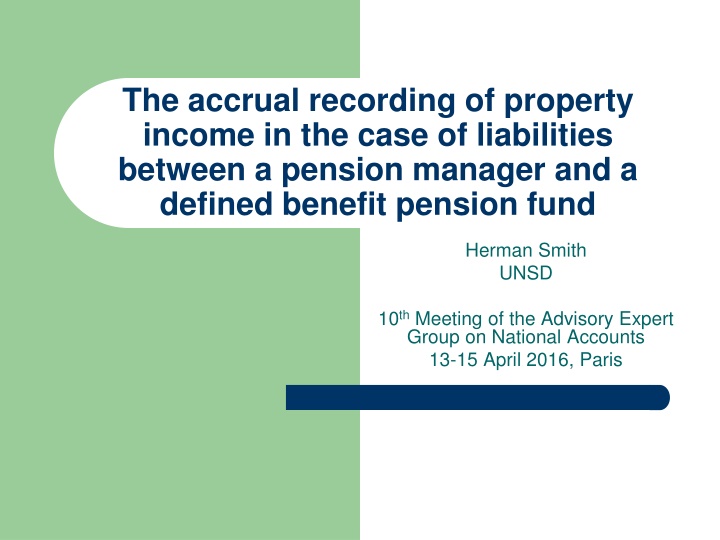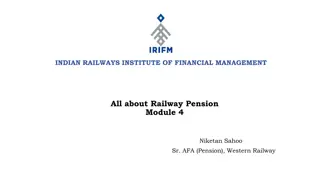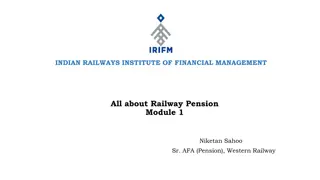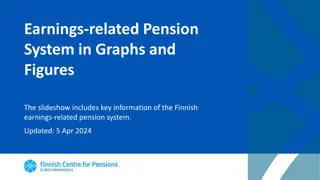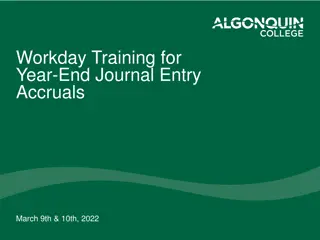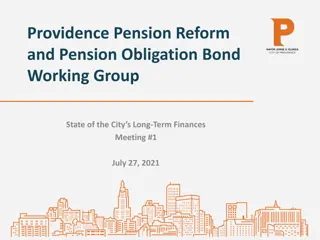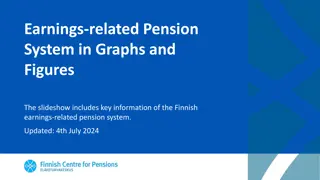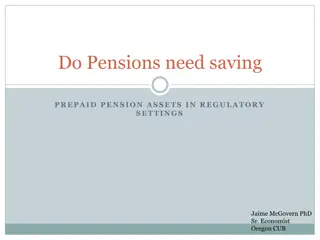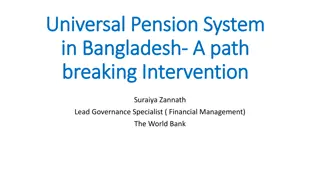Accrual Recording of Property Income in Pension Management
The accrual recording of property income in the context of liabilities between a pension manager and a defined benefit pension fund involves accounting for differences in investment income and pension entitlements. This process aims to reflect the actual property income earned by the pension fund, considering underfunding or overfunding scenarios. Imputed property income is crucial in determining the financial flow between the pension manager and the fund, affecting how accrued income is classified. The method ensures accuracy and transparency in financial reporting for pension management.
Download Presentation

Please find below an Image/Link to download the presentation.
The content on the website is provided AS IS for your information and personal use only. It may not be sold, licensed, or shared on other websites without obtaining consent from the author.If you encounter any issues during the download, it is possible that the publisher has removed the file from their server.
You are allowed to download the files provided on this website for personal or commercial use, subject to the condition that they are used lawfully. All files are the property of their respective owners.
The content on the website is provided AS IS for your information and personal use only. It may not be sold, licensed, or shared on other websites without obtaining consent from the author.
E N D
Presentation Transcript
The accrual recording of property income in the case of liabilities between a pension manager and a defined benefit pension fund Herman Smith UNSD 10thMeeting of the Advisory Expert Group on National Accounts 13-15 April 2016, Paris
Introduction 2008 SNA states that a pension manager (PM) is responsible for meeting the liabilities of a defined benefit pension fund (DBPF) When actual assets of DBPF is not equal to pension entitlements a claim of the DBPF on the PM is recorded in the financial accounts and balance sheets in the case of underfunding and conversely in the case of overfunding => Net Worth of DBPF is equal to zero, by definition 2
Introduction Unwinding of the discount factor on the pension entitlement is shown as property income flowing from the DBPF to households to account for past service increase When DBPF is persistently under or over funded the investment income promised to pension beneficiaries would not be equal to the actual property income earned by the DBPF AEG in 2014 agreed that to account for this difference an explicit accrued property income flow should be recorded between the PM and the DBPF This would reflect the difference between the unwinding of the discount factor and the actual property income 3
Property income Actual and imputed components: The actual component represents the investment income receivable from the accumulated assets held by the pension fund The imputed component represents the investment income receivable from the claim between the DBPF and the PM. For practical purposes it is calculated as the difference between the actuarially calculated property income and the actual property income from the accumulated assets of the pension fund 4
Imputed property income Underfunded DBPF with a claim towards the PM: Property income payable to households (unwinding of the pension entitlements, related to increase in pension entitlements from past service ) 4.0 Property income accrued on accumulated assets: Imputed property income receivable from claim on pension manager (residual): 2.2 1.8 The AEG had two views on how to classify the imputed property income on the claim towards the PM: As investment income payable on pension entitlements (D442) As interest (D41) 5
Questions at the pensions w/s How to treat: the divergence between investment performance of the actual assets of the pension fund and the discount rate; holding gains and losses; asset value volatility; other economic flows affecting the value of the pension entitlements (e.g. demographic changes); Should the claim of the DBPF on the PM generate property income. To calculate the imputed property income by assuming the return on the claim is equal to the discount factor 6
The divergence between investment performance of the actual assets of the pension fund and the discount rate follow the same procedure as with calculating imputed pension contributions when the actual investment income is more than the actuarially determined investment income the imputed investment income would be negative 7
Holding gains and losses Following the SNA principle to exclude holding gains and losses in the measurement of income it seems logical to also exclude holding gains and losses from the actual property income earned by the DBPF 8
Asset value volatility and other flows The investment income on pension entitlements is actuarially determined irrespective of the value of the actual assets. To be consistent with the accrual recording of the property income flow between the PM and the DBPF it seems reasonable to expect that changes in the size of the imputed property income are related to the changes in the claim. 9
Should the claim of the DBPF on the PM generate property income 2008 SNA 7.144: the source of the investment income payable may not be investment income itself, but for the SNA, the decisive criterion for recording this as investment income is that of the recipient who regards these payments as the rewards for putting financial assets at the disposal of the insurance corporation. 2008 SNA 7.148 states: The investment income payable on defined contribution entitlements is equal to the investment income on the funds plus any net operating surplus earned by renting land or buildings owned by the fund Use general concept of property income until there is more clarity on the classification of the imputed investment income 10
Alternative calculation of the imputed property income To assume that the return on the claim is equal to the discount rate would be more consistent with the definition of interest. This approach was basis for discussion at the previous AEG meeting As the investment income is actuarially determined the residual estimate of the return on the claim is in principle also equal to the discount factor. the residual method has the advantage of being easier to calculate in cases where there is a divergence between investment performance of the actual assets of the pension fund and the discount rate 11
Classification as Investment Income Payable on Pension Entitlements 2008 SNA links assets with the type of income derived from that asset Claims of the pension fund on the pension manager are related to asset type AF64 (Claim of pension fund on pension managers, which is part of AF6: Insurance, pensions, and standardized guarantee schemes) The investment income categories related to asset type AF6 are shown in income category D44 (Investment income disbursements), which has a subcategory for pension entitlements (D442: Investment income payable on pension entitlements) This income is excluded from the definition of interest, which is defined as the return on specified financial instruments that do not include AF6 The coherence of the general framework points to classifying the accrued property income as D442 However, D442 was designed to only capture the claims of households on pension funds and the flow from pension schemes to households 12
Classification as Interest The income on the claim of a defined DB pension fund towards a pension manager is income on an accrued claim, which: Could have arisen for a number of reasons Did not arise as a result of any special relationship between households and the pension fund SNA defines interest as a form of income that is receivable by the owners of certain kinds of financial assets, namely: deposits, debt securities, loans and (possibly) other accounts receivable for putting the financial asset at the disposal of another financial institution The claim under discussion is the claim of a creditor over a debtor that has accrued and the income accruing is compensation for the time value of money 13
Other Issues Separately identify the unwinding of discount factor in defined benefit pension funds from investment income on defined contribution pension schemes These items are driven by different factors Review the SNA definition of interest, taking into consideration a more conceptual definition Capacity to generate income or offset future expenditures Consider the need for a separate category of investment income related to the income on the accumulated pension entitlements distributed to households 14
Issues for Consideration Express its views on the pension w/s questions and proposed solutions Decide on the classification of the accrued property income flow between a pension manager and a defined benefit pension fund arising from the difference between the unwinding of the discount factor and the actual property income 15
Issues for Consideration Express views on: Separately identify the unwinding of the discount factor in DB funds from the investment income on DC pension funds The conceptual definition of interest The need for a separate category of income related to the investment income on the accumulated pension entitlements distributed to households 16
Thank you 17
